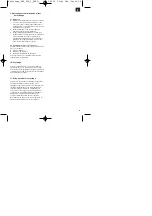
13
GB
It is vital to avoid all contact with electric cables.
Do not use the hammer screwdriver in a
potentially explosive atmosphere.
Dust may be a health hazard for the person
operating the equipment. This applies to dust
being created and whirled up during the
operation of the equipment. Depending on the
material you wish to process, dusts and gases
may arise that are a health hazard for the user
(for example causing cancer, birth defects,
asthma and / or dermatitis).
Wear a breathing mask.
Make sure that escaping air whirls up as little
dust as possible.
Noise can cause permanent damage to your
hearing. Unprotected exposure to high levels of
noise can result in loss of hearing and other
problems such as tinnitus (ringing, buzzing,
whistling or droning noises in your ears). Wear
ear-muffs. To keep noise and vibration levels as
low as possible, follow the maintenance and
operating instructions in the manual. If required
by the particular situation, vibration-damping
material used as an intermediate layer can also
reduce noise.
Only use suitable plug-on attachments.
Vibrations can be transferred to the whole body,
particularly the arms and hands. Very strong and
continuous vibrations can cause neural and
vascular disorders. Regular work breaks will
minimize the risk of disorders caused by
vibrations.
Hold the equipment with a light but secure grip,
noting the reaction forces which arise in the
process. The risk of disorders caused by
vibrations is always greater with a tight grip.
Wear warm clothing when you work in cold
surroundings. Keep your hands warm and dry.
If you suffer pains or repeat symptoms while
using the equipment, do not ignore them but
consult a doctor.
Do not let cold air flow over your hands.
Compressed air can cause serious injuries.
Never direct escaping compressed air at yourself
or at any other person.
Disconnect the compressed air coupling and
depressurize the equipment before you service,
repair or transport the equipment and before you
change tools.
Do not carry compressed air tools by their hose.
Never allow the tool to run unloaded at full idle
speed for an extended period of time.
The compressor and lines can become very hot
during operation. Touching these parts will burn
you.
The gas and steam sucked in by the compressor
must be kept free of impurities that could cause
fires or explosions in the compressor.
Keep your hands away from the installed tool
(connector), to prevent injuries.
Only qualified and trained persons are allowed to
use this equipment.
Do not modify this equipment. Modifications can
impair the effect of the safety devices and
therefore increase the potential danger for the
user.
Make the operating instructions available to
every user.
Check the rating plate and markings on the
equipment regularly for legibility. If there is any
damage, contact our Service Center.
Use and service the equipment as recommended
in the operating instructions. This will help you to
minimize dust, gas, noise and vibrations.
If dust or gas arises, they must be checked as a
priority at the moment they arise.
Select, service and use the consumables / plug-
in tools as recommended in the operating
instructions. This will help you to prevent
unnecessary dust, gas, noise and vibrations.
Stop using the equipment if you experience
numbness, tingling, pain or whitening of the skin
on your fingers or hands and consult a doctor.
Whipping hoses may cause serious injuries.
Always check the equipment for damaged or
loose hoses and connections.
Do not use any quick-lock couplings at the air
inlet. Use hose connections with a hardened
steel thread (or a material with comparable
resistance to vibrations).
If universal rotary couplings (claw couplings) are
used, lock pins must be installed and a retention
system for compressed air hoses used in order
to protect against possible faulty connections
(“hose to tool” or “hose to hose”).
2. Layout (Fig. 1/2)
1.
Setting screw (torque)
2.
Trigger lever
3.
Reverse facility (clockwise/counter-clockwise)
4.
Square driver mount for connector
5.
Adjusting screw
6.
Nipple
7.
Extension attachment
8.
Special compressed air oil
9.
Plug-on attachments (sizes: 9 mm, 10 mm, 11
mm, 13 mm, 14 mm, 17 mm, 19 mm,
22 mm, 24 mm, 27 mm)
Anleitung_DSS_260_2_SPK7:_ 22.03.2012 10:46 Uhr Seite 13














































